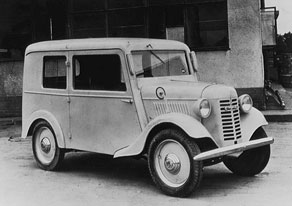 |
The first postwar Datsun

On August 15, 1945, Japan accepted the terms of the Potsdam Agreement and thus ended the war in defeat. Under the Occupation, automobile production was banned by the General Headquarters (GHQ) of the Allied Powers. Eventually the ban on trucks was lifted, and in June 1947 the manufacture of passenger cars was permitted. However, production was limited to 300 small passenger cars with a displacement of under 1,500cc, and 50 large passenger cars.
Nissan restarted production at its Yoshiwara Plant, turning out the first postwar Datsun passenger car in August that year. But production was restricted to parts in stock, which meant that at first only prewar models could be manufactured.
The first new Datsun model to be designed after the war was the Standard Sedan Type DA, launched in 1947. In fact, though, only the body was new. Both the chassis and the engine were prewar designs. The engine was the same 722cc unit used for the Datsun Type 17. After all restrictions on production were lifted, the newly styled Deluxe Sedan Type DB was launched in 1949, followed by the Thrift Sedan Type DS in 1951, replacing the Type DA.
|
 |



This Datsun Sedan Type DA, launched in 1947, was the first model to be designed after the war. Its styling was distinguished by straight lines that facilitated the manufacturing process. |
